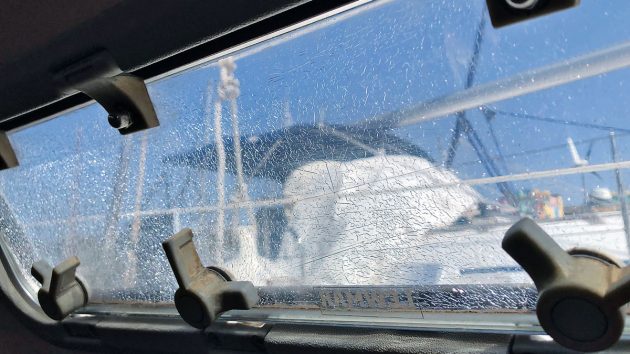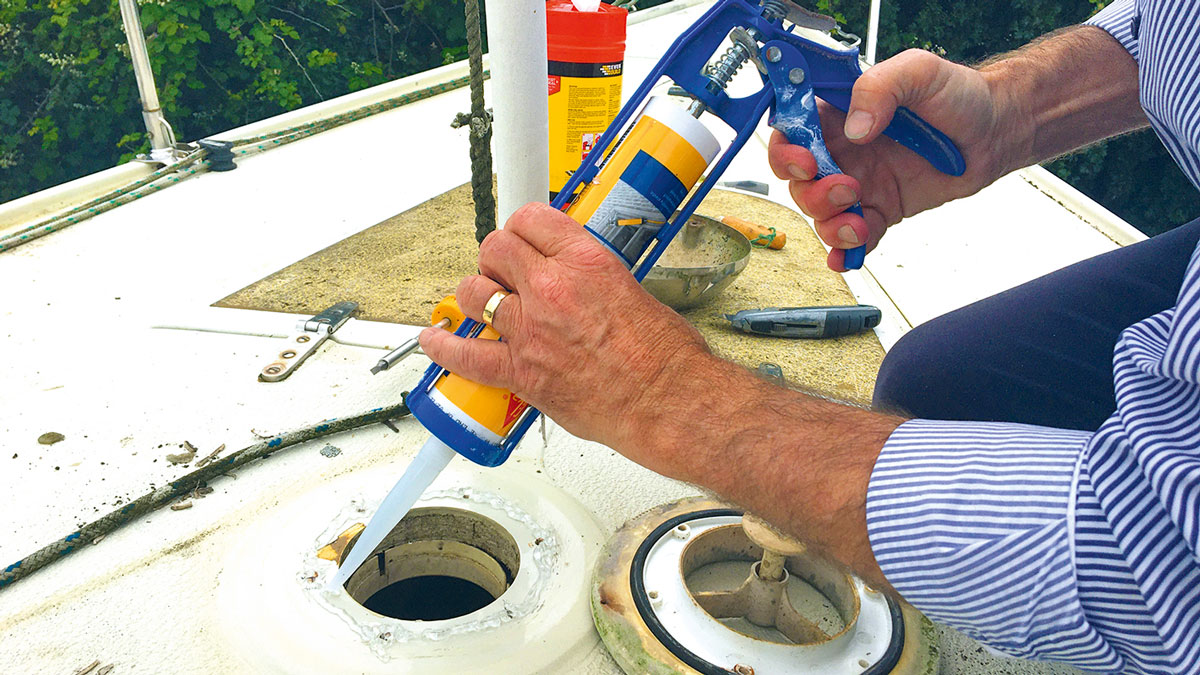Stu Davies saves a bundle by having new acrylic windows made
My Beneteau 381 is now 24 years old: the time has flown by since we bought her 14 years ago and things are starting to need replacing.
Among them the Lewmar portlight lenses have crazed – as they all eventually do – and look unsightly. The hatch lights are the same.
I looked at the replacement costs of the portlight lenses and found the prices to be rather horrifying: £85-ish for the smaller ones and around £180 for the larger ones.
The portlights fitted to my boat and other yachts of that era up until 2000 or so are called the Old Standard Portlight and lenses are made from flat stock Perspex.

Old weathered sealing strip on the boat portlights. Credit: Stu Davies
The newer ones, the Standard Port Light, as my neighbour in Portugal has found out, have part of the latching mechanism moulded into the lens and so they can’t be cut from flat stock Perspex.
They are just as expensive and in his case (he has a Dufour 36 Classic and Dufour apparently had some special sizes commissioned for their boats) replacement lenses are like hen’s teeth now.
Being a good PBO-er I started doing some research.
We all call the material lenses are made of Perspex but in fact the material is acrylic, the common name for Polymethyl Methacrylate (PMMA) which is produced by manufacturers around the world.
Some of the most common brands available in the UK are Perspex, Plexiglas, Policril, Acryglas and Acrycast.

Computer controlled laser cutter at Westminster Plastics. Credit: Stu Davies
I’ve known for some years that plastic sign manufacturers can make simple shapes but I’ve found out that their capabilities have moved on in leaps and bounds with the advent of CNC machines and laser cutters.
So I started looking to see if sign makers could make the simple Old Standard Portlight lenses.
Continues below…
Best marine sealants and adhesives for boat jobs
With help from adhesive and sealant expert Laurie Brebner, PBO’s Ali Wood explains which works best for different jobs on…
Bonding marine windows back in: the best gasket sealant
PBO reader Nicholas Phillips wants advice on the best gasket sealant for bonding his marine windows. Our expert Sven Petersen…
Polyurethane vs silicone sealants: Which is best for use on boats?
They’re not the same as adhesives but some sealants – such as Sikaflex – do have adhesive properties. There are…
How to install boat portholes
Phil Taylor reduces the size of the windows on his Sabre 27 by fitting portholes for offshore sailing
The answer is yes they can and I then found plastics shapes manufacturer Westminster Plastics on Wrexham Industrial Estate which has CNC and laser cutting machines.
With a careful measurement of the old lens (I had in my workshop an old No4 lens and so took this along as a pattern) into the computer it goes, then the machines do the donkey work.
No more hand cutting and drilling with the fear of cracking the plastic. Beneteaus have smoked green plastic lenses but some boats have smoked grey.
The basic material is available in these colours but the company would have to buy a complete sheet of it to make a few small prototypes, so I opted for clear plastic which the firm had in stock.

Pulling sealant from the window frame. Credit: Stu Davies
I had two size 4 lenses cut and they were done in a day. They were perfect with beautiful cuts and holes and best of all they only cost £45 each, a big saving on official prices.
The basic fitting is just a question of undoing bolts and screws to swap over the mounting and closing hardware. I’m now carefully making tracings of the smaller lenses to have a full set made.
After that, the hatchlights are the next project!
The seals that the lens closes against also degrade.
They’re basically 9mm outside diameter closed-cell neoprene round seals with an arrowhead moulding on one side which slots into the frame’s aluminium housing.

New acrylic lens is a vast improvement over the crazed one. Credit: Stu Davies
But these seals are also silly prices – more than £50 just for one.
I already had on the boat some 9mm round closed-cell neoprene sealing material which I’d found on ebay.
The seals are basically large O-rings and they can be cut to size and the ends superglued together, a trick I was taught as a young fitter when I worked in the local steelworks many years ago.
So I pulled out the old silicone sealing and cleaned out the frame grooves.
I then carefully measured a new piece of seal alongside the old one, put it in place in the frame, and trimmed it to suit before supergluing the ends together.
I did a dry run before applying sealant into the arrow groove in the frame, aiming to hold the seal in place by glueing it with sealant. And it worked!
The ‘L’ closing and locking levers were a bit tight at first but a light dusting with talcum powder soon lubricated them enough to get them turning.
Talc (not silicone grease or Vaseline which doesn’t seem to help on plastics) was also applied to the shafts going through the lens and the sealing O-rings which butt against the lenses.
Frame leaks

A frame gap can be a source of leaks in boat portlights. Credit: Stu Davies
My boat’s aluminium portlight frames are in two parts with a horizontal gap on both sides on the exterior.
The sealing material degrades in these two gaps over the years and water enters and goes through internal channels into the interior of the frame and this then drips into the boat.
A careful clean out of these gaps and the application of Sikaflex 291 reseals these and the leak stops!
Enjoyed reading How to replace crazed boat portlights? 
A subscription to Practical Boat Owner magazine costs around 40% less than the cover price.
Print and digital editions are available through Magazines Direct – where you can also find the latest deals.
PBO is packed with information to help you get the most from boat ownership – whether sail or power.
-
-
-
- Take your DIY skills to the next level with trusted advice on boat maintenance and repairs
- Impartial in-depth gear reviews
- Practical cruising tips for making the most of your time afloat
-
-








